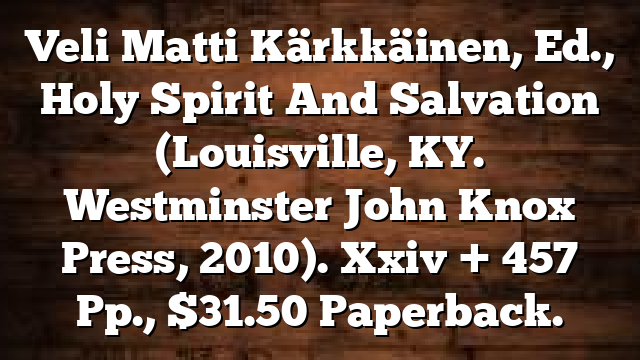Click to join the conversation with over 500,000 Pentecostal believers and scholars
Click to get our FREE MOBILE APP and stay connected
| PentecostalTheology.com



Book Reviews / Pneuma 34 (2012) 95-159
101
Veli-Matti Kärkkäinen, ed., Holy Spirit and Salvation (Louisville, KY.: Westminster John Knox Press, 2010). xxiv + 457 pp., $31.50 paperback.
Works dedicated to primary source material are not abundant in the expanding plethora of pneumatology writings. Certainly not many are available having such scope as this one. This volume aims to pull together in one place the most salient writings in the history of Chris- tian reflection on the relationship between the Holy Spirit and salvation. It is a broader representation of soteriology typical of much of Christian history that does not correspond tightly to the neat categories and narrow conceptions of an ordu salutis more typical of modernity, including Pentecostalism. Kärkkäinen also rides the crest of the current renais- sance in pneumatology sweeping across a variety of academic disciplines. In so doing, he contributes to our understanding of the Spirit as anything but absent in the soteriological writings of the Greek and Latin fathers, medieval mystics, and scholastics, Reformation theologians, and contemporary theologies.
Kärkkäinen takes his cues from the increased knowledge of, and appreciation for the rich pneumatological traditions of the Eastern churches. Other factors providing impetus include awareness of the general ‘oblivion of the Spirit’ in the West due to the de-personalizing of the Spirit defined in the Augustinian tradition as the bond of love between the Father and the Son as well as the debate over the filioque clause in the Niceno-Constantinopolitan Creed that the East argues subordinates the Spirit to Jesus. Furthermore, like many of his contemporaries, Kärkkäinen is intent on restoring pneumatology to a place of its own within the spectrum of Christian theology rather than incorporating it into another doctrine(s).
Just over half of the book is given to the history of pneumatological traditions over the first nineteen centuries of Christianity, with the second half providing an overview of con- temporary theologies of the Spirit and salvation. Beginning with recognition of the richness of the biblical witness to the Spirit, Kärkkäinen sets out to demonstrate that right from the inception of the Christian message, awareness of the activity of the Spirit was clearly evi- dent, though pneumatological reflection was slow in coming due to the need for develop- ment of christological clarity.
A primitive understanding of the Spirit is evident in the writings of the first two centuries but also evident in widespread recognition of the use and legitimacy of the charisms. Excerpts from Irenaeus, Hippolytus, Tertullian, and others show a much-increased empha- sis on the Spirit likely precipitated, at least in part, by the influence of Montanism. The author divides his selection of post-Nicene writings on the Spirit between the Greek/Eastern fathers and Latin fathers, highlighting the former because of their key influence in the devel- opment of pneumatological doctrine. He includes writings from the East that together clearly indicate a shared trinitarian faith such as those of Athanasius, the Cappadocians, and Pseudo-Macarius, and from the Western church the intense bibliocentric reflections of Hilary of Poitiers and Ambrose as well as Augustine’s affirmations of the Spirit as “Very God” and as “Love” and “Gift.”
Likewise, in attempting the almost impossible task of representing the shape of medieval pneumatology, Kärkkäinen divides his selections between the traditions of the East and West, highlighting the “prophetic-apophatic” (102) sayings of Pseudo-Dionysius, the mysti- cal theology of Maximus the Confessor and Symeon the New Theologian, and the powerful
© Koninklijke Brill NV, Leiden, 2012 DOI: 10.1163/157007412X621743
1
102
Book Reviews / Pneuma 34 (2012) 95-159
deification exposition of Gregory Palamas. From the West, he includes the poetic experien- tial narratives of Hildegard of Bingen and Catherine of Siena, and the mystical spirituality of Joachim of Fiore and Bernard of Clairvaux. He concludes his survey of medieval pneumatol- ogy with portions from the scholastic theologians Anselm of Canterbury and the great summa writer, Thomas Aquinas.
Reformation writings on the Spirit, the place of which Kärkkäinen sees as central to a cor- rect understanding of the theological vision of the Reformers, are presented in three groups: the mainstream Protestant Reformers — Luther, Calvin, and Zwingli, Roman Catholic pneumatological thinkers and mystics Ignatius Loyola, John of Avila, and John of the Cross, and Radical Reformers Thomas Muntzer and Menno Simons. Selections from post-Reforma- tion renewal movements emphasizing “heart religion” (190) are taken from the writings of key figures within Puritanism, Pietism, Methodism, and Quakerism.
The author limits nineteenth century pneumatological theologies to the modern Protes- tant reflections of Schleiermacher and Hegel, the neo-Calvinist movements represented by Kuyper, and the Princeton theologians Warfield, the Hodges, and Strong. These materials he appropriately considers needful to include as a transition to the explosive developments in renewal that would characterize the twentieth century and beyond. It was out of their “vig- orous antithesis and rebuttal” (241) that American fundamentalism and evangelicalism emerged and that in turn influenced the rise of modern Pentecostalism.
Teachers especially of contemporary theology and particularly within a Pentecostal con- text will find Part II of this work to be a wealth of primary material on the Spirit and salva- tion, albeit with each entry being understandably brief. Kärkkäinen is quick to point out the “diversity, plurality, and pluriformity” (275) of contemporary pneumatological thinking, the unprecedented interest in the study and experience of the Spirit, and the new emerging interpretations. In this second and final section, more recent reflections on the Eastern Orthodox, Roman Catholic, and Protestant pneumatological traditions are included along with contextual interpretations such as feminist, political, and ecological pneumatologies. The themes represented here are not considered to be entirely new creations as much as new configurations of Spirit theology for new contexts.
A more comprehensive sampling of sources of pneumatogical reflection would be diffi- cult to find. This work can appropriately be called a labor of love for both teacher and stu- dent. As with any work of this type though, it runs the risk of not adequately representing a writer when brief excerpts are lifted from their original setting. The single most obvious weakness, it seems, is the brevity of commentary, which can oversimplify a particular writ- er’s perspective. Yet, it is only in this way that Kärkkäinen could be successful in producing such an astonishing array of pneumatological perspectives. The result is a great read and an invaluable resource for anyone interested in renewal.
Reviewed by Ewen Butler
Regent University, Virginia Beach, Virginia ewenbut@regent.edu
2




Most Talked About Today